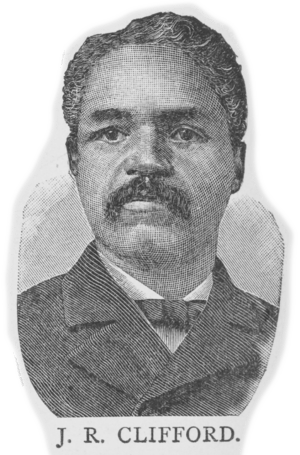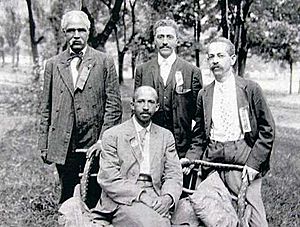J. R. Clifford facts for kids
Quick facts for kids
John Robert Clifford
|
|
|---|---|

Portrait of J.R. Clifford
|
|
| Born | September 13, 1848 Williamsport, Virginia, U.S. |
| Died | October 6, 1933 (aged 85) Martinsburg, West Virginia, U.S. |
| Occupation |
|
| Literary movement | African-American journalism Niagara Movement Civil Rights |
| Notable works | The Pioneer Press |
J.R. Clifford (born September 13, 1848 – died October 6, 1933) was a very important person in West Virginia's history. He was the first African-American lawyer in the state. Clifford was also a newspaper publisher, editor, and writer. He worked as a school teacher and a principal too.
He was a Civil War veteran and a pioneer for civil rights. He helped start the Niagara Movement, which was a group that worked for equal rights. This movement later led to the creation of the NAACP. Even with many challenges due to racial discrimination, Clifford achieved great things. This showed his amazing talent and strong will.
Contents
Biography of J.R. Clifford
John Robert Clifford was born on September 13, 1848. He was born in a small town called Williamsport. This area was then part of Hardy County, Virginia. Today, it is in Grant County, near Moorefield.
Early Life and Education
Clifford's parents, Isaac and Mary Clifford, were "free blacks." This meant they were not enslaved. His family had lived in that part of Virginia for many years. There were no schools for Black children in the area. So, Clifford's parents sent him to Chicago in the early 1860s. He went there to get an education from J. J. Healy.
Military Service
In 1864, when he was just fifteen, Clifford joined the United States Colored Troops. He served in the 13th Regiment of Heavy Artillery. He stayed in the army until 1865 and became a Corporal. After the war ended, he worked as a nurse.
Becoming a Teacher and Lawyer
After the Civil War, Clifford learned how to be a barber. He moved to Zeno, Ohio and went to writing school. In 1870, he moved to Wheeling, West Virginia. There, he ran his own writing school. From 1871 to 1873, he had a similar school in Martin's Ferry, Ohio.
In the early 1870s, he went to Storer College in Harpers Ferry. This college was new and created to educate African Americans in the region. After finishing his degree in 1878, Clifford became a teacher. Later, he became the principal of a public school for African Americans in Martinsburg, West Virginia. While in Martinsburg, he studied law with J. Nelson Wirner. He became a very successful lawyer.
Newspaper Publisher and Civil Rights Leader
In 1882, Clifford started his own newspaper called "The Pioneer Press." This newspaper was sent all over the country. It was mainly read by African Americans. In 1884, he was chosen to be a delegate for the Republican National Convention. However, some groups took back their votes because he was Black. Clifford used his newspaper to speak out against this unfairness. He published "The Pioneer Press" until 1917. It was the longest-running weekly newspaper focused on African American issues at that time.
In 1887, Clifford made history again. He became the first African American lawyer allowed to practice law in West Virginia. He worked as a lawyer for 45 years. He was also very active in politics at both state and national levels. Clifford was a founder of the Niagara Movement. He worked with other important civil rights leaders like W. E. B. Du Bois. In 1906, the Niagara Movement held its first meeting in the United States. It took place in Harpers Ferry. This movement was a key step toward forming the NAACP a few years later. It is seen as the start of the modern Civil Rights Movement.
Family and Later Life
On December 28, 1876, J. R. Clifford married Mary Elizabeth Franklin. She was 17 years old and from Lexington, Virginia. They got married in Harpers Ferry, West Virginia. They had ten children together.
J.R. Clifford passed away in Martinsburg, West Virginia, in 1933. He was 85 years old. He is buried at Arlington National Cemetery.
Williams v. Board of Education
In 1898, Clifford won a very important case about civil rights and education. This case was heard by the West Virginia Supreme Court of Appeals. It was called Williams v. Board of Education.
The Case for Equal Education
Clifford argued against the Tucker County Board of Education. The school board had decided to make the school year shorter for African-American children. Their school year was only five months, while white students had a full nine-month school year. Mrs. Carrie Williams, who taught at the Black school, asked Clifford for help. He told her to keep teaching for the full nine months, even if she wasn't paid.
Clifford then filed a lawsuit against the school board. He demanded that Mrs. Williams be paid for the extra months she taught. Clifford won the case in a jury trial. Then, he won again when the case went to the West Virginia Supreme Court of Appeals. The court's decision was a big victory. It helped make sure that African-American students across the state had equal rights to education.
Impact of the Victory
Clifford's win in the Williams case happened more than 50 years before the famous "Brown v. Board of Education" case. It was one of the few times a southern state's highest court supported civil rights before the 1900s. The J. R. Clifford Project is an organization that works to remember Clifford's life. They even perform re-enactments of this important trial.
The court said that treating Black people differently just because of their skin color was wrong. They said it went against the law and fairness. The court also said that education was very important for Black people. They had been held in slavery and needed education to become good citizens. This would help keep the country strong and free. Clifford won $121.00 for the teacher's unpaid salary.
Niagara Movement

J.R. Clifford was one of the people who helped start the Niagara Movement. This group was led by W. E. B. Du Bois and William Monroe Trotter. The Niagara Movement disagreed with some other Black leaders. They wanted full civil rights for Black Americans right away. They also wanted to end segregation, which was the separation of people by race. This movement is seen as a key part of the 20th Century civil rights movement. It was also the group that led to the creation of the National Association for the Advancement of Colored People (NAACP).
Meeting at Harpers Ferry
Clifford helped organize the movement's second meeting. This was the first meeting held in the United States. It took place in Harpers Ferry, West Virginia. This town is famous because of John Brown's raid in 1859. The meeting lasted three days, from August 15 to 18, 1906. It happened at Clifford's old college, Storer College. Today, Storer College is part of Harpers Ferry National Historical Park.
People at the meeting talked about how to get civil rights for African Americans. Du Bois later said it was "one of the greatest meetings that American Negroes ever held." Attendees walked from Storer College to a nearby farm. This was where John Brown's fight against slavery ended. They took off their shoes to show respect for the ground. They also had a ceremony to remember the past.
Clifford later left the Niagara Movement when it became the NAACP in 1909. One reason was that he didn't like the use of the word "colored" in the organization's name.
In 2006, the National Park Service celebrated 100 years of the Niagara Movement at Harpers Ferry. The J. R. Clifford Project performed their re-enactment of the "J.R. Clifford and the Carrie Williams Case" at this event.
Prince Hall Masonry
John R. Clifford was a high-ranking member of the Masons. He was a 32nd Degree Mason. He also gave talks for the Most Worshipful Prince Hall Grand Lodge of West Virginia. He was a Past Grand Master of West Virginia.
Commemorated on the U.S. Stamp
In 2009, Clifford was honored on a United States Postal Service postage stamp. He was one of twelve civil rights pioneers featured in a special stamp series.

